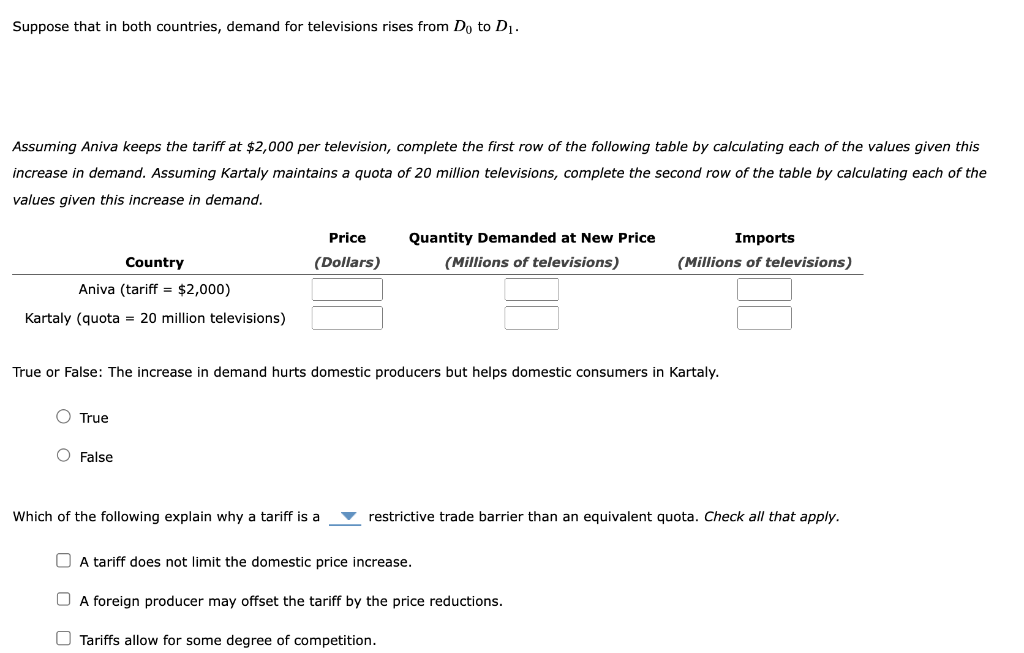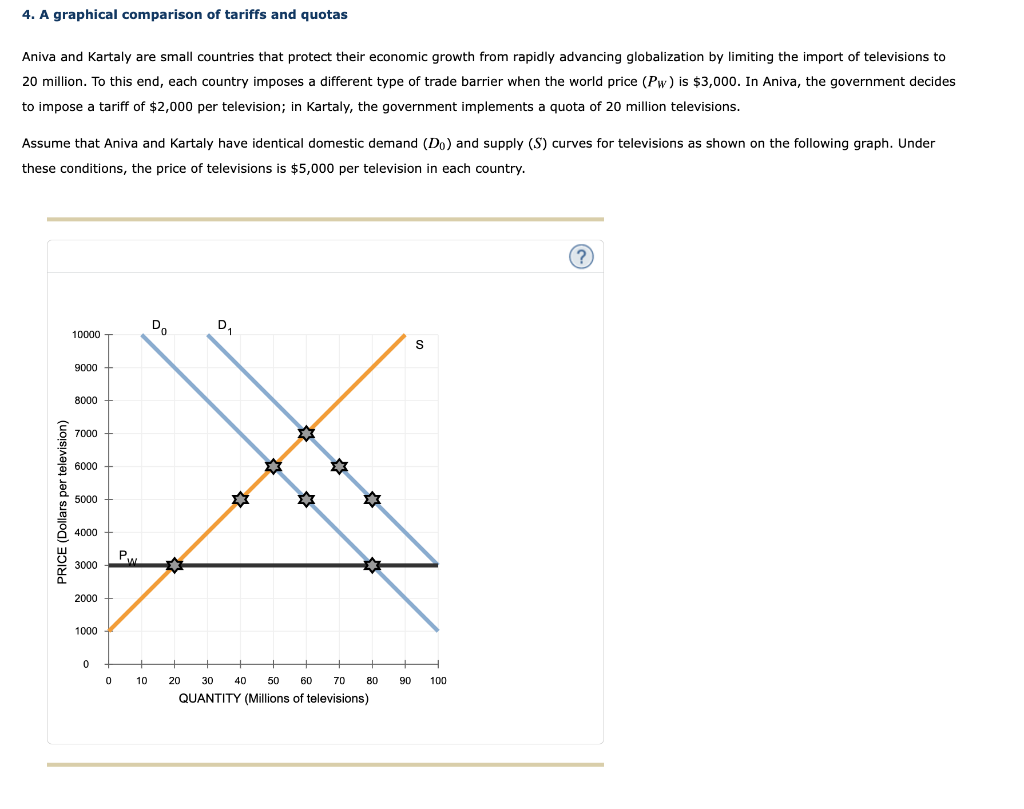Suppose that in both countries, demand for televisions rises from Do to D₁. Assuming Aniva keeps the tariff at $2,000 per television, complete the first row of the following table by calculating each of the values given this increase in demand. Assuming Kartaly maintains a quota of 20 million televisions, complete the second row of the table by calculating each of the values given this increase in demand. Country Aniva (tariff = $2,000) Kartaly (quota = 20 million televisions) O True Price (Dollars) O False True or False: The increase in demand hurts domestic producers but helps domestic consumers in Kartaly. Quantity Demanded at New Price (Millions of televisions) Which of the following explain why a tariff is a Imports (Millions of televisions) restrictive trade barrier than an equivalent quota. Check all that apply. A tariff does not limit the domestic price increase. A foreign producer may offset the tariff by the price reductions. Tariffs allow for some degree of competition.
Suppose that in both countries, demand for televisions rises from Do to D₁. Assuming Aniva keeps the tariff at $2,000 per television, complete the first row of the following table by calculating each of the values given this increase in demand. Assuming Kartaly maintains a quota of 20 million televisions, complete the second row of the table by calculating each of the values given this increase in demand. Country Aniva (tariff = $2,000) Kartaly (quota = 20 million televisions) O True Price (Dollars) O False True or False: The increase in demand hurts domestic producers but helps domestic consumers in Kartaly. Quantity Demanded at New Price (Millions of televisions) Which of the following explain why a tariff is a Imports (Millions of televisions) restrictive trade barrier than an equivalent quota. Check all that apply. A tariff does not limit the domestic price increase. A foreign producer may offset the tariff by the price reductions. Tariffs allow for some degree of competition.
Brief Principles of Macroeconomics (MindTap Course List)
8th Edition
ISBN:9781337091985
Author:N. Gregory Mankiw
Publisher:N. Gregory Mankiw
Chapter14: A Macroeconomic Theory Of The Open Economy
Section: Chapter Questions
Problem 4PA
Related questions
Question

Transcribed Image Text:Suppose that in both countries, demand for televisions rises from Do to D₁.
Assuming Aniva keeps the tariff at $2,000 per television, complete the first row of the following table by calculating each of the values given this
increase in demand. Assuming Kartaly maintains a quota of 20 million televisions, complete the second row of the table by calculating each of the
values given this increase in demand.
Country
Aniva (tariff = $2,000)
Kartaly (quota = 20 million televisions)
True
Price
(Dollars)
O False
True or False: The increase in demand hurts domestic producers but helps domestic consumers in Kartaly.
Quantity Demanded at New Price
(Millions of televisions)
Which of the following explain why a tariff is a
Imports
(Millions of televisions)
restrictive trade barrier than an equivalent quota. Check all that apply.
A tariff does not limit the domestic price increase.
A foreign producer may offset the tariff by the price reductions.
Tariffs allow for some degree of competition.

Transcribed Image Text:4. A graphical comparison of tariffs and quotas
Aniva and Kartaly are small countries that protect their economic growth from rapidly advancing globalization by limiting the import of televisions to
20 million. To this end, each country imposes a different type of trade barrier when the world price (Pw) is $3,000. In Aniva, the government decides
to impose a tariff of $2,000 per television; in Kartaly, the government implements a quota of 20 million televisions.
Assume that Aniva and Kartaly have identical domestic demand (Do) and supply (S) curves for televisions as shown on the following graph. Under
these conditions, the price of televisions is $5,000 per television in each country.
PRICE (Dollars per television)
10000
9000
8000
7000
6000
5000
4000
3000
2000
1000
0
0
PW
10
Do
D₁
☆
☆
☆
20 30 40 50 60 70
QUANTITY (Millions of televisions)
80
S
90 100
(?)
Expert Solution
This question has been solved!
Explore an expertly crafted, step-by-step solution for a thorough understanding of key concepts.
This is a popular solution!
Trending now
This is a popular solution!
Step by step
Solved in 4 steps

Knowledge Booster
Learn more about
Need a deep-dive on the concept behind this application? Look no further. Learn more about this topic, economics and related others by exploring similar questions and additional content below.Recommended textbooks for you

Brief Principles of Macroeconomics (MindTap Cours…
Economics
ISBN:
9781337091985
Author:
N. Gregory Mankiw
Publisher:
Cengage Learning

Essentials of Economics (MindTap Course List)
Economics
ISBN:
9781337091992
Author:
N. Gregory Mankiw
Publisher:
Cengage Learning

Principles of Macroeconomics (MindTap Course List)
Economics
ISBN:
9781285165912
Author:
N. Gregory Mankiw
Publisher:
Cengage Learning

Brief Principles of Macroeconomics (MindTap Cours…
Economics
ISBN:
9781337091985
Author:
N. Gregory Mankiw
Publisher:
Cengage Learning

Essentials of Economics (MindTap Course List)
Economics
ISBN:
9781337091992
Author:
N. Gregory Mankiw
Publisher:
Cengage Learning

Principles of Macroeconomics (MindTap Course List)
Economics
ISBN:
9781285165912
Author:
N. Gregory Mankiw
Publisher:
Cengage Learning

Principles of Microeconomics (MindTap Course List)
Economics
ISBN:
9781305971493
Author:
N. Gregory Mankiw
Publisher:
Cengage Learning

Principles of Economics, 7th Edition (MindTap Cou…
Economics
ISBN:
9781285165875
Author:
N. Gregory Mankiw
Publisher:
Cengage Learning

Principles of Economics (MindTap Course List)
Economics
ISBN:
9781305585126
Author:
N. Gregory Mankiw
Publisher:
Cengage Learning